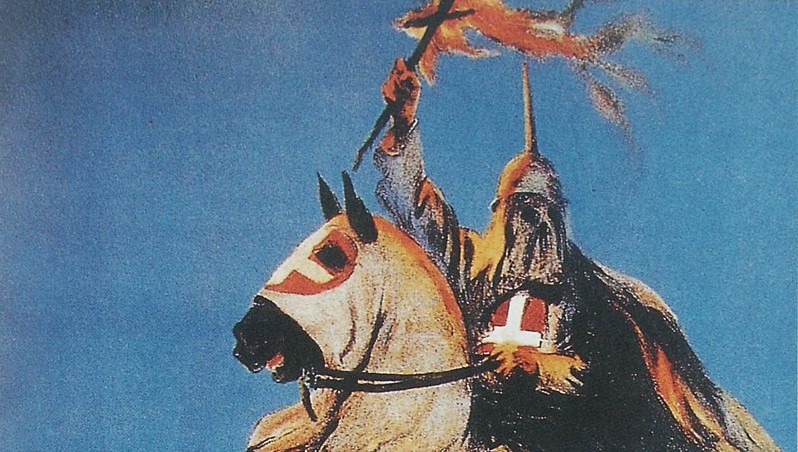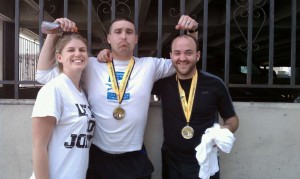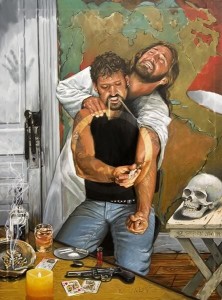





My Marathon
Almost a year ago, I was having a conversation with one of my best friends, John Chaney, and we decided to run a marathon together. He suggested a half marathon, I mocked his masculinity, and we agreed to run the full marathon in Austin. And about a week ago, on February 20th, we ran the full marathon, 26.2 miles, around the relatively hilly streets of Austin, Texas. Even though it was days ago, I’m still trying to digest the experience. I think it might help to parse things out a bit.
The Training
Despite my dreams, there was no “Heart’s on Fire” montage or any other heroics. And, despite my hopes, it was tough. Originally, my plans were for a sustained training program (here come the excuses). I had a hard time in the Lubbock heat (especially given the city’s apparent hatred for functioning water fountains), and my schedule really got thrown off when I had gall bladder surgery, got married, and went on my honeymoon in the span of a few weeks. When I finally got back on schedule, it was early in the fall, and I had to use an abbreviated schedule.
It was tough. I know that sounds obvious, but I feel like it deserves to be mentioned. I’m a runner, and I figured gradually running further once a week wouldn’t make that big of a deal. I was wrong. I kind of hit my threshold early on around 8 miles. That lasted until a run where I accidentally went further than what I was supposed to do–the GPS on my iMapMyRun app wasn’t working and when I threw my route onto GoogleEarth after the workout it revealed I had run about 9.5 miles. I was good to go until about 16 miles, when I plateaued out again. This lasted a few weeks, until I was finally able to push through it under optimum conditions (good weather, no deadlines, and my hydration belt finally arrived). I maxed out at 20 about three weeks before the race, and stepped down the training until I reached Austin.
The Race
I jogged about 1.5 miles the day before the race, during which I remembered just how much I missed running in Austin. The night before John and I (accompanied by our wives) went out for pasta at the Tree House Italian Grill (John’s meal was apparently great, mine was definitely awful). We went to bed at a decent hour, woke up at 5:45 a.m., and made our way to the starting line. At 7:00 a.m., the race started.
Well, sort of. About 20,000 runners actually participated in the Austin marathon (~13,000 half-marathoners, ~6,000 full marathoners, and ~? 5K runners), and so it took us about 16 minutes to actually cross the start line. John-John and I were aiming for about 11 minute miles, and we stayed pretty close to that for the first 16 miles or so. It was rough. I thought the toughest part would be the point in the race where the half-marathoners broke off to finish (and we kept on going), but the real tough part was around mile 16 or 17, where you realized that you still had over two hours of running left to go. Ouch. Anyway, at that point, I had to slow down a bit (some miles more so than others), but I owe my time to John. He was a true friend, doubling back a little bit and jogging alongside me. I think he probably could have ran it about 30 minutes faster (and I could have run it about 30 minutes slower), but he took one for the team. I tried to get him to run ahead, but he (obviously) refused. I owe a great deal of the enjoyment of the race to John.
The rest I owe to the crowds. I’ve run races before (5K, 5 mile, 10K), and while the crowd was great (esp. in that last kick), I never thought it would be so essential. In Austin, people lined the streets, bands randomly played, people had speakers blasting music (the runners absolutely lost it around mile 7 when some guy was playing Thriller), and in general just being really supportive. I almost punched some guy who said we were currently on “the last hill” (it was not) and the few people who said we were “almost done” (we were not), but the thousands of other people were giving out free high fives, cheering us on, holding up signs (my favorites were “Because 26.3 miles would be insane” and “If this marathon course was easy, it would be called your mom!”), handing out bananas and candies and orange slices, and just generally being awesome. I never thought cheering could mean so much, but between miles 17 and 22, it meant everything.
26.2 miles later, we crossed the finish line.
My Reaction
Overall, it was a great experience to have, but honestly, as of right now, I just don’t see me doing another one. On the one hand, I think it would be really cool to become a marathoner, traveling around, working on improving my time, and finding other cool marathons to run (my colleague John ran the Minneapolis marathon and said it was excellent–I’ve also always dreamed of running the San Diego marathon, which is supposed to be gorgeous). Then again, I really love to run (I really do). And during the training process, I really started to dread going running. It was great for the extra motivation during the middle of the week (on the 4 – 6 mile runs), but Sunday just loomed in the distance. It was depressing waiting for the run, especially right before I left (“I’m going to run 18 miles…I’ll be back around 3:30”). It would absorb the entire day and, while Lubbock has its moments, the city was just not made for long runs (flat and boring).
Whether I run another race or not is irrelevant. What I can say is that I finished a marathon. The time was not great. The experience was rough. The training wasn’t pretty. But dammit, I finished. I consider it one of my greatest accomplishments, and I’m honestly proud of what I did.

Racist? So What?
I think I might start putting up an occasional entry about my graduate class. This semester, for the first time, I’m teaching the course “Race and Media” and it’s actually going really well. I keep waiting for the conversation to die down, but each night it seems that there are more and more questions and issues thrown around in the discussion.
I had a class on race and media at the University of Iowa. It was taught by Tim Havens, who did a great job keeping a discussion going without going the traditional discussion leader route. That said, I also had a race class taught by the irreplaceable, essential Mary Campbell. I’ve tried to combine the two approaches, while adding in a number of readings I’ve picked up over the years and, like I said, so far it’s going really well.
This week, one of the readings came from Eduardo Bonilla-Silva’s book Racism Without Racists, and this particular excerpt really stood out to me. In this chapter, Bonilla-Silva is examining the oft-cited phenomenon of people declaring tolerance, but harboring beliefs that suggest otherwise (in other words, “I’m not a racist, but…”). I talked about it with my race class and I think the discussion went well, but I just can’t stop thinking about it:
“First, readers need to be reminded that I see racism as a problem of power. Therefore, the intentions of individual actors are largely irrelevant to the explanation of social outcomes. Second, based on my structural definition of “racism,” it should also be clear that I conceive racial analysis as “beyond good and evil.” The analysis of people’s racial accounts is not akin to an analysis of people’s character or morality.”
This could easily represent a fundamental disconnect between academia and the “real world”–if I call you a racist, you’d probably get offended. However, I think the distinction is an important one.
If I know that a certain stereotype exists (e.g., “White people like sour patch kids”), that doesn’t mean I believe it. Hell, I can understand the wonderful complexity that is Santa Claus, but I don’t think he’s climbing down our non-existent chimney anytime soon. In other words, my ability to recognize that stereotype doesn’t mean I’m going to buy random White people delicious sour patch kids.
That said, can you really separate recognition and belief when it comes to race? When Bonilla-Silva writes that analysis of racial accounts is not akin to an analysis of people’s character or morality, I have to question that, at least on some level.
This was further complicated by, of all things, an episode of House. No, this isn’t a diatribe against the steep decline of a once-great show (though after a weekend of watching episodes from a few seasons ago, I could write volumes on the subject. I’ll let the A.V. Club handle it). I was watching a rerun on USA and the patient-of-the-week was a woman who had turned into a functioning psychopath. They were quick to point out that not all psychopaths or sociopaths are killers, but I couldn’t help but wonder why not. I mean, the symptoms are all there–aren’t they just waiting for opportunity?
Yes, I understand the compartmentalization of these kind of issues, and I get that there is a difference between understanding stereotypes and internalizing them. But if you understand stereotypes, haven’t you already internalized them, at least to a certain extent? If I’m at the store and I’m supposed to buy a snack for some White person and I don’t know what they like, if the first thing that pops into my mind is sour patch kids, doesn’t that make it an issue? Of course I would shrug it off and dismiss it as a stereotype, it feels like the damage is done. There are a number of fascinating studies (with fascinating methodologies) showing that people tend to respond faster in an emergency if the victim is of the same race. If my schema instantly connects White people and sour patch kids, in an emergency, doesn’t that make me a racist? And shouldn’t there be some sort of consequence for feeling that way?
I realize there are more questions here than answers, but I’m fascinated by the discussion, and I hope I can find an answer (or what might help explain this anyway) by the end of the semester.

That’s Cool
About a month ago, I heard an interesting piece of news: The Dutch are giving out free heroin.
At first I just assumed it was some neoconservative scare tactic, another example of those wacky Europeans and their crazy notions about how to live life (OMG TEH LIBS ARR GOING TO FORCE OUR KIDS TO TAKE DRUGGGSS!!!1!!one!!). But I finally got a chance to read up on the situation in this Economist article, and I have to say that I am intrigued.
Obviously, heroin is a dangerous drug–it makes you do crazy, unthinkable stuff and it can destroy your life. Just ask these guys:
And yet, the Dutch government continues to hand out heroin for free, and it appears to be successful. So why is this so effective? To people get heroined out? Is too much of a good thing a bad thing? Did all of their druggies OD in the first week, thereby reducing the number of addicts to be counted for the next drug survey?
Actually, it’s none of these things. The Dutch have realized a fundamental truth that eludes many people: Drugs are cool, and government is uncool.
Allow me to quote at length from the Economist article I linked to earlier:
“[The Dutch government] has been giving them free heroin, as long as they show up to inject at government-run “safe injection points,” under the eyes of police and health staff. Dutch drug researchers now say that the youth population “doesn’t relate to hard drugs at all”, and that there’s no danger that Dutch kids reading the advice site will find heroin use attractive. They’re more likely to find it pathetic.”
I really cannot stress the genius of this approach, and I’m surprised it’s not used more frequently here in the United States. Each year, the debate over mascot caricatures is reignited, particularly in Cleveland where the old die-hard fans cannot understand why some people would find “Chief Wahoo” offensive. Yeah, not at all offensive.
After all, what’s a little racism between fans?
That said, those offended by the mascot are going about this completely wrong. Forget petitioning the organization–you’re just drumming up media attention (and thereby reinforcing hegemony when, time and time again, Chief Wahoo (really?) continues smiling gullibly at crowds entering The Jake). Go the Dutch route and make Chief Wahoo uncool. Come up with alternative designs or logos and sell them underground if you have to. Build on that, create a following, and Chief Wahoo will become something far worse than an offensive stereotype.
It will become uncool.


